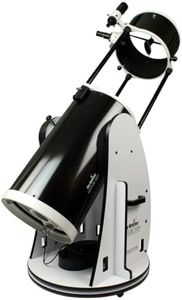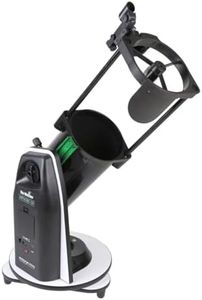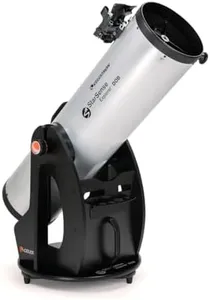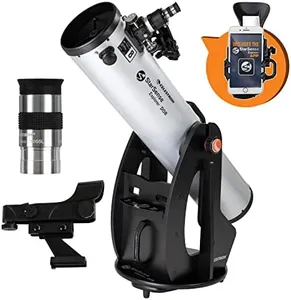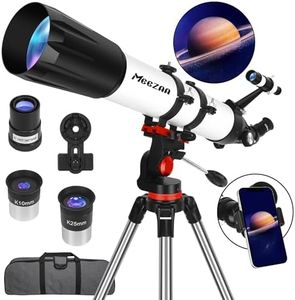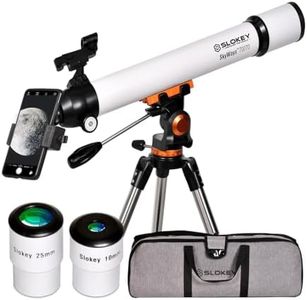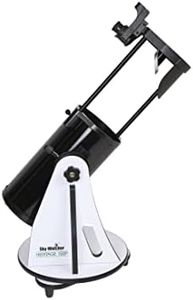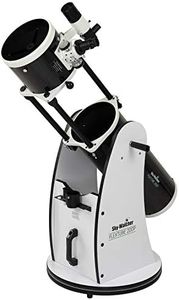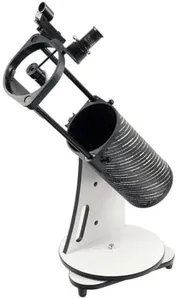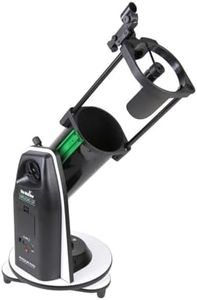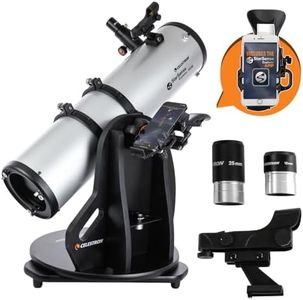10 Best Dobsonian Telescopes 2025 in the United States
Our technology thoroughly searches through the online shopping world, reviewing hundreds of sites. We then process and analyze this information, updating in real-time to bring you the latest top-rated products. This way, you always get the best and most current options available.

Our Top Picks
Winner
Celestron StarSense Explorer 12-inch App-Enabled Telescope – 305mm Dobsonian with Smartphone Dock & StarSense App – iPhone & Android Compatible – Easy-to-Use for Beginners
Most important from
154 reviews
The Celestron Starsense Explorer 12" Dobsonian telescope stands out with its large 12-inch (304 mm) aperture, which allows you to see faint deep-sky objects like nebulae, galaxies, and star clusters with impressive clarity. This is a big plus for anyone interested in serious stargazing, especially at darker locations. Its manual focus and Plossl eyepieces provide decent viewing options, though it comes with a single eyepiece, so you might want to invest in additional ones for more versatility.
The telescope uses an altazimuth mount, which is user-friendly and makes it easy to point the scope up and down or side to side — a good fit for beginners and casual observers alike. A unique feature is the StarSense Explorer technology that connects to your smartphone and helps you quickly locate celestial objects, removing some of the guesswork often involved in finding targets in the night sky. However, this model is quite heavy at about 84 pounds and fairly large (56 x 26 x 29 inches), so it’s not very portable or easy to move around frequently. This makes it ideal for setting up in a permanent or semi-permanent spot rather than for taking on hikes or travel.
The included reflex finderscope is basic, which is fine for beginners but might feel limiting as you gain experience. This telescope represents a strong choice if you want a powerful Dobsonian for detailed views of deep-sky objects combined with helpful smartphone guidance, provided you don’t mind its size and weight.
Most important from
154 reviews
SkyWatcher Flextube 300 SynScan Dobsonian 12-inch Collapsible Computerized GoTo Large Aperture Telescope (S11820)
Most important from
59 reviews
The SkyWatcher Flextube 300 SynScan Dobsonian is a 12-inch aperture telescope, which is quite large and ideal for bright, detailed views of the night sky, making it great for serious stargazers wanting to see planets, star clusters, and deep-sky objects. The telescope uses an altazimuth Dobsonian mount, known for its simplicity and stability, which is excellent for beginners and hobbyists alike. One standout feature is its collapsible tube design, which makes it easier to transport compared to traditional solid tubes—handy if you plan to move it between locations. It weighs about 99 pounds when assembled, so while collapsible, it’s still a bit heavy, meaning it’s best if you have a vehicle to carry it.
The built-in SynScan computerized GoTo system with WiFi control lets you find and track over 42,000 celestial objects, which is a major plus if you’re new to sky navigation or want automated convenience. It comes with two wide-angle Plossl eyepieces (25mm and 10mm), providing good starting magnifications, but you might want to add more eyepieces later for varied viewing. The all-metal gearing and highly reflective mirrors ensure steady, sharp images, though the focus is auto, which may not be as fast as manual for some users.
This telescope combines a large aperture and computerized tracking with a design that balances performance and portability, making it suitable for dedicated amateur astronomers willing to handle some weight for a high-quality, feature-rich Dobsonian experience.
Most important from
59 reviews
Sky Watcher Sky-Watcher Virtuoso GTI 150P Collapsible Tabletop GoTo Dobsonian Telescope
Most important from
45 reviews
The Sky Watcher Sky-Watcher Virtuoso GTI 150P Collapsible Tabletop GoTo Dobsonian Telescope is a versatile choice for astronomy enthusiasts. With a 150mm aperture, it provides bright and clear views of celestial objects. Its fast f/5 optics increase light gathering power, making it suitable for observing the Moon, planets, galaxies, and nebulae. The 750mm focal length strikes a good balance for various types of observations.
The Altazimuth mount is relatively simple to use and, combined with the patented Freedom Find technology, allows for manual control without losing alignment. Built-in Wi-Fi and GoTo capabilities via the SynScan Pro app make finding and tracking objects easier for beginners and experienced users alike. However, at 25.8 pounds, its portability may be a concern for some, especially compared to smaller, lighter models. The collapsible design helps mitigate this somewhat, making it easier to store and transport.
Accessories are somewhat limited, with a reflex finderscope included. It's compatible with both iOS and Android devices, adding to its modern appeal. This telescope is ideal for those looking for a balance of manual and automated control within a manageable size and weight.
Most important from
45 reviews
Buying Guide for the Best Dobsonian Telescopes
Dobsonian telescopes are a popular choice for amateur astronomers due to their simplicity, ease of use, and affordability. They are known for their large apertures, which allow for excellent light-gathering capabilities, making them ideal for deep-sky observations. When choosing a Dobsonian telescope, it's important to consider several key specifications to ensure you select the best fit for your needs. Understanding these specs will help you make an informed decision and enhance your stargazing experience.FAQ
Most Popular Categories Right Now

